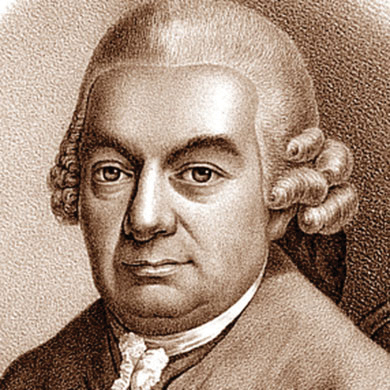Composed 1786: 10 minutes
 Of C. P. E. Bach’s 16 surviving solo sonatas, 11 are for flute with basso continuo (usually harpsichord and cello, as with tonight’s recital), plus one solo, unaccompanied sonata. He wrote the first two sonatas around the time of his studies in Frankfurt. Then came a group of five, written while in Berlin likely just before he received his appointment as Court Harpsichordist to the future Frederick the Great. A little later, while accompanying the evening concerts in the royal palaces of Berlin and Potsdam, he wrote three new flute sonatas, 1746-7, steering clear of territory claimed by the royal flautist, Johann Joachim Quantz, with his several hundred flute sonatas and concertos written for the regal fingers. Two decades later, Bach became, essentially, city church music director in Hamburg, leaving behind a court that was reluctant to recognize his talents. It was not until 1786 that Bach, now in his 70s, wrote his final flute sonata, 40 years after its predecessor and, for historical context, just five years before the death of Mozart. (It was given the Wq. number 133 in the catalog made by Alfred Wotquenne in 1905, H. 564 in that by Eugene Helm from 1989.) The sonata is in two movements rather than the usual three, with a short, curious bridge passage between the two, keeping the listener guessing as to the direction the music is heading. The figured bass line and accompanying basso continuo maintain traditional Baroque practice, while the florid flute writing and embellished passagework call for an expert technique.
Of C. P. E. Bach’s 16 surviving solo sonatas, 11 are for flute with basso continuo (usually harpsichord and cello, as with tonight’s recital), plus one solo, unaccompanied sonata. He wrote the first two sonatas around the time of his studies in Frankfurt. Then came a group of five, written while in Berlin likely just before he received his appointment as Court Harpsichordist to the future Frederick the Great. A little later, while accompanying the evening concerts in the royal palaces of Berlin and Potsdam, he wrote three new flute sonatas, 1746-7, steering clear of territory claimed by the royal flautist, Johann Joachim Quantz, with his several hundred flute sonatas and concertos written for the regal fingers. Two decades later, Bach became, essentially, city church music director in Hamburg, leaving behind a court that was reluctant to recognize his talents. It was not until 1786 that Bach, now in his 70s, wrote his final flute sonata, 40 years after its predecessor and, for historical context, just five years before the death of Mozart. (It was given the Wq. number 133 in the catalog made by Alfred Wotquenne in 1905, H. 564 in that by Eugene Helm from 1989.) The sonata is in two movements rather than the usual three, with a short, curious bridge passage between the two, keeping the listener guessing as to the direction the music is heading. The figured bass line and accompanying basso continuo maintain traditional Baroque practice, while the florid flute writing and embellished passagework call for an expert technique.